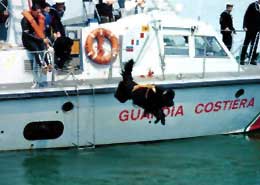|
WHO ARE WE? We are the Italian School of Rescue Dogs, the largest national organisation dedicated to the training of dogs and their handlers for water rescue. This Dog Training Centre accepts all breeds of dogs as long as their weight is over 30 kg. and they are confident in water. To fully appreciate the dogs importance, with the assistance of the dog the handler can resuscitate a person whilst still in the water. Rescue dogs reach a very high degree of performance developing their power and stamina: one dog alone can pull a boat full of 30 people for between 300 and 2000 metres. At this time dog and trainer swim side by side in complete synchronisation as this is essential during a rescue. The School organises courses for handlers and a qualification certificate (S.I.C.S.) is issued on successfully reaching the required standard. This certificate is recognised by the Ministry of Transport and Navigation and the Port Authorities. In 1997 the certificate issued by the Italian School of Rescue Dogs was updated on the basis of experience of Ferruccio Pilenga, National Instructor. The Italian School of Rescue Dogs is the only Institution in Europe to organise yearly classes for heli-rescue dogs. They also collaborate with the Italian heli-rescue teams (Air Rescue, Airforce, Police, Customs, Firemen and Civil Defence). THE DOG RESCUE STORY Just imagine this story of possibly the first rescue by a dog, taken from an old book of sailors anecdotes. Spectacular exhibitions, daily work and enthusiasm gave life to legendary deeds.
This romantic story started a dream in Ferruccio Pilenga’s mind to restore the deeds of dog rescue in water and this was begun 10 years ago now. This dream became reality: on the decks of the historical vessel Palinuro of the Military Navy, the life and habits of ancient sailors, sailing from port to port with their faithful Terranova on board, have been reconstructed. A Documentary has been made for Italian Television Channel 3 programme entitled ‘The Wonder Planet’, were we see these animals re-propose the ancient rescue abilities. Ferruccio Pilenga considers this documentary to be the crowning point of his long work developing the Dog Training Centre. The idea of creating the training school for water rescue dogs and to obtain legal acknowledgement of the dog training centre validity was figured in the 80’s. Ferruccio Pilenga and his colleagues achieved the standards that they have reached today by studying and collaborating with Coast Guards on the modern techniques used. As a first step they got acquainted with dinghy, helicopter, sailing and air instruments. Secondly, they concentrated on the dog and its training techniques, giving way to the most creative phase of the project, creating a very strong dog/master relationship both relying on the other. Pilenga, a volunteer of the Civil Protection, started with one female Terranova called Mas and from this 10 bases have been created around Italy, the first was in Sarnico on the Iseo lake. All are open for 48 weeks of the year and offer training to those who wish to obtain the certificate for the first time or renew their old one if it has expired. There are 30 national instructors who work at the 10 bases; their activity is forming and updating thus increasing professionally the Centre to equal the traditional rescue team standard. A lifeguard is paid and is employed were security is an investment. All of the dogs and their handlers are volunteers and freely offer their services anywhere that they are required and are a valid assistance to Coast-guards and Port Authorities. This work, carried out daily, gives plenty of satisfactions but not enough for Pilenga who created this worthwhile organisation from nothing. Recently he went to Germany to help the local Civil Protection. He remarked that German equipment and team were excellent but they do not have dogs training centres. A demonstration in the North Sea with our best dogs will follow soon. New targets then, the interest in them shows how the project is vivid and in constant evolution. We will accept any dog that is large enough, although the general opinion is that the Terranova and the Labrador are the most suitable dogs. A dog breed and his handler inexperience are not an obstacle if there is the will to share work and play with our animal. To conclude, we wish this particular school to reach new targets as it certainly would be “to our benefit” is any beach could be cared by the four friendly eyes of the dog training unit. |
 An ancient sailing boat, crewed
by 150 sailors, busy pulling ropes and unfolding sails, was fighting against a storm. Suddenly a huge wave
crashed on to the deck. To the dismay of those on board they saw a man washed overboard. Everybody felt helpless. Suddenly a black shape leapt
into the freezing water and surging waves, catching the man and pulling him back to the boat saving his life. The hero had four paws, thick long
black fur and answered to the name of his land of origin “Terranova” (Newfoundland).
An ancient sailing boat, crewed
by 150 sailors, busy pulling ropes and unfolding sails, was fighting against a storm. Suddenly a huge wave
crashed on to the deck. To the dismay of those on board they saw a man washed overboard. Everybody felt helpless. Suddenly a black shape leapt
into the freezing water and surging waves, catching the man and pulling him back to the boat saving his life. The hero had four paws, thick long
black fur and answered to the name of his land of origin “Terranova” (Newfoundland).